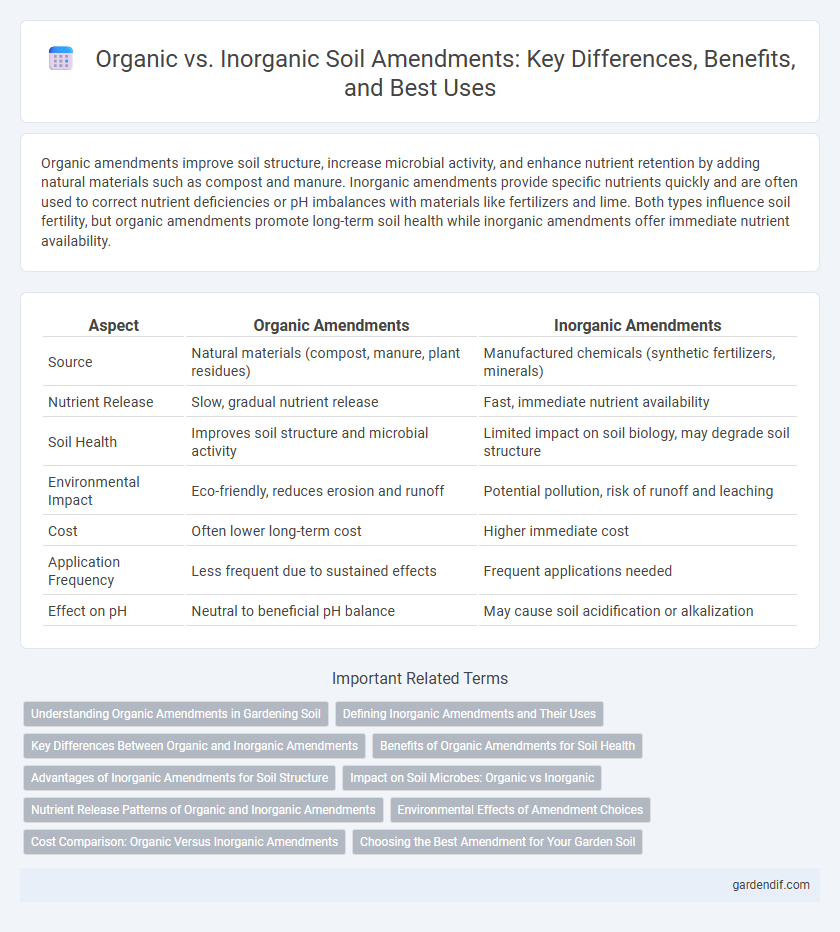
Organic amendments vs Inorganic amendments Illustration
Organic amendments improve soil structure, increase microbial activity, and enhance nutrient retention by adding natural materials such as compost and manure. Inorganic amendments provide specific nutrients quickly and are often used to correct nutrient deficiencies or pH imbalances with materials like fertilizers and lime. Both types influence soil fertility, but organic amendments promote long-term soil health while inorganic amendments offer immediate nutrient availability.
Table of Comparison
| Aspect | Organic Amendments | Inorganic Amendments |
|---|---|---|
| Source | Natural materials (compost, manure, plant residues) | Manufactured chemicals (synthetic fertilizers, minerals) |
| Nutrient Release | Slow, gradual nutrient release | Fast, immediate nutrient availability |
| Soil Health | Improves soil structure and microbial activity | Limited impact on soil biology, may degrade soil structure |
| Environmental Impact | Eco-friendly, reduces erosion and runoff | Potential pollution, risk of runoff and leaching |
| Cost | Often lower long-term cost | Higher immediate cost |
| Application Frequency | Less frequent due to sustained effects | Frequent applications needed |
| Effect on pH | Neutral to beneficial pH balance | May cause soil acidification or alkalization |
Understanding Organic Amendments in Gardening Soil
Organic amendments improve gardening soil by increasing nutrient content, enhancing microbial activity, and boosting water retention. Common organic materials include compost, manure, and peat moss, which decompose gradually to release essential nutrients and improve soil structure. These amendments promote sustainable soil health by fostering beneficial soil organisms and reducing dependency on chemical fertilizers.
Defining Inorganic Amendments and Their Uses
Inorganic amendments are mineral-based materials such as lime, gypsum, and chemical fertilizers that improve soil structure, pH balance, and nutrient availability. They deliver essential nutrients like nitrogen, phosphorus, and potassium in concentrated forms, enhancing plant growth and crop yields. These amendments are commonly used for rapid soil adjustment and to correct specific nutrient deficiencies in agricultural and horticultural soils.
Key Differences Between Organic and Inorganic Amendments
Organic amendments consist of natural materials like compost, manure, and crop residues that improve soil structure, water retention, and microbial activity, enhancing long-term soil fertility. Inorganic amendments, such as synthetic fertilizers and lime, provide specific nutrients in readily available forms but may not improve soil physical properties or microbial health significantly. Organic amendments release nutrients slowly and support sustainable soil ecosystems, while inorganic amendments deliver immediate nutrient supply but often require repeated applications to maintain soil productivity.
Benefits of Organic Amendments for Soil Health
Organic amendments enhance soil structure, increase microbial activity, and improve nutrient retention by adding valuable organic matter. They promote soil biodiversity, boost water-holding capacity, and reduce erosion risks. Unlike inorganic amendments, organic amendments support long-term soil fertility and resilience.
Advantages of Inorganic Amendments for Soil Structure
Inorganic amendments such as gypsum and lime improve soil structure by enhancing soil aggregation and reducing compaction, leading to better aeration and water infiltration. These amendments provide consistent nutrient availability, particularly calcium and magnesium, which stabilize soil particles and promote root penetration. Their rapid solubility and predictable effects enable precise management of soil pH and texture in both acidic and alkaline soils.
Impact on Soil Microbes: Organic vs Inorganic
Organic amendments, such as compost and manure, significantly enhance soil microbial diversity and activity by providing essential nutrients and improving soil structure. Inorganic amendments, including synthetic fertilizers, often lead to rapid nutrient availability but can reduce microbial biomass and diversity due to soil acidification and nutrient imbalances. These contrasting impacts influence soil health, nutrient cycling, and long-term fertility, with organic amendments generally promoting a more sustainable microbial ecosystem.
Nutrient Release Patterns of Organic and Inorganic Amendments
Organic amendments release nutrients gradually through microbial decomposition, enhancing long-term soil fertility and structure, while inorganic amendments provide a rapid nutrient supply due to their soluble chemical forms. The slow nutrient release from organic materials reduces leaching and improves nutrient use efficiency, contrasting with the quick, sometimes excessive nutrient availability from inorganic fertilizers that can lead to environmental losses. Understanding these nutrient release patterns is critical for optimizing fertilizer management and sustaining soil health in agricultural systems.
Environmental Effects of Amendment Choices
Organic amendments enhance soil biodiversity and structure by increasing microbial activity and improving water retention, leading to reduced erosion and carbon sequestration. Inorganic amendments often supply precise nutrient ratios but may cause soil acidification, nutrient leaching, and potential contamination of water bodies. Sustainable soil management increasingly favors organic inputs for their long-term environmental benefits, reducing greenhouse gas emissions and promoting ecosystem resilience.
Cost Comparison: Organic Versus Inorganic Amendments
Organic amendments generally have a lower upfront cost but may require higher long-term investment due to slower nutrient release and increased labor for application. Inorganic amendments, while often more expensive initially, provide immediate nutrient availability and reduced labor costs, potentially lowering total expenses over time. Cost efficiency depends on soil type, crop requirements, and sustainability goals, with organic amendments favoring ecological benefits and inorganic options prioritizing rapid nutrient supply.
Choosing the Best Amendment for Your Garden Soil
Organic amendments, such as compost and manure, improve soil structure, increase microbial activity, and provide long-lasting nutrient release, enhancing overall soil health. Inorganic amendments, including synthetic fertilizers and minerals like gypsum, deliver immediate nutrient availability but may lead to soil degradation if overused. Selecting the best amendment depends on soil test results, crop requirements, and environmental sustainability goals.
Organic amendments vs Inorganic amendments Infographic

 gardendif.com
gardendif.com